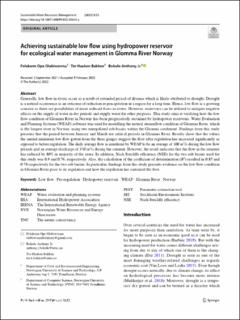| dc.contributor.author | Olabiwonnu, Folakemi Ope | |
| dc.contributor.author | Bakken, Tor Haakon | |
| dc.contributor.author | Bokolo, Anthony Junior | |
| dc.date.accessioned | 2022-09-06T12:43:27Z | |
| dc.date.available | 2022-09-06T12:43:27Z | |
| dc.date.created | 2022-02-28T08:11:10Z | |
| dc.date.issued | 2022 | |
| dc.identifier.issn | 2363-5037 | |
| dc.identifier.uri | https://hdl.handle.net/11250/3016040 | |
| dc.description.abstract | Generally, low flow in rivers occur as a result of extended period of dryness which is likely attributed to drought. Drought is a natural occurrence as an outcome of reduction in precipitation in a region for a long time. Hence, low flow is a growing concern as there are possibilities of more reduced flows in rivers. However, reservoirs can be utilized to mitigate negative effects on the supply of water in dry periods and supply water for other purposes. This study aims at verifying how the low flow condition of Glomma River in Norway has been progressively sustained by hydropower reservoirs. Water Evaluation and Planning Systems (WEAP) software was used for modelling the natural streamflow condition of Glomma River, which is the longest river in Norway, using two unregulated sub-basins within the Glomma catchment. Findings from this study presents that the period between January and March are critical periods in Glomma River. Results show that the values the annual minimum low flow gotten from the three gauges suggest the flow after regulation has increased significantly as opposed to before regulation. The daily average flow is simulated by WEAP to be an average of 100 m3/s during the low flow periods and an average discharge of 350 m3/s during the summer. However, the result indicates that the flow in the summer has reduced by 80% in majority of the years. In addition, Nash Sutcliffe efficiency (NSE) for the two sub basins used for this study was 0.9 and 0.76, respectively. Also, the calculation of the coefficient of determination (R2) resulted in 0.85 and 0.78 respectively for the two sub basins. In particular, findings from this study presents evidence on the low flow condition in Glomma River prior to its regulation and how the regulation has sustained the flow. | en_US |
| dc.language.iso | eng | en_US |
| dc.publisher | Springer | en_US |
| dc.rights | Navngivelse 4.0 Internasjonal | * |
| dc.rights.uri | http://creativecommons.org/licenses/by/4.0/deed.no | * |
| dc.title | Achieving sustainable low fow using hydropower reservoir for ecological water management in Glomma River Norway | en_US |
| dc.type | Peer reviewed | en_US |
| dc.type | Journal article | en_US |
| dc.description.version | publishedVersion | en_US |
| dc.source.journal | Sustainable Water Resources Management | en_US |
| dc.identifier.doi | https://doi.org/10.1007/s40899-022-00643-y | |
| dc.identifier.cristin | 2005924 | |
| cristin.ispublished | true | |
| cristin.fulltext | original | |
| cristin.qualitycode | 1 | |

